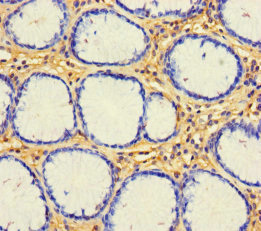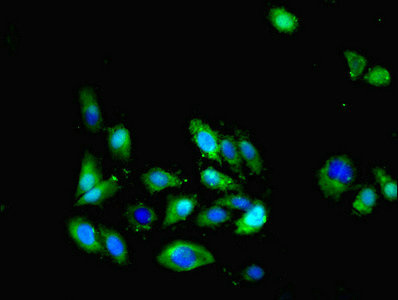CX3CL1 Antibody
-
货号:CSB-PA06087A0Rb
-
规格:¥440
-
促销:
-
图片:
-
Immunohistochemistry of paraffin-embedded human kidney tissue using CSB-PA06087A0Rb at dilution of 1:100
-
Immunohistochemistry of paraffin-embedded human gastric cancer using CSB-PA06087A0Rb at dilution of 1:100
-
Immunofluorescent analysis of Hela cells cells using CSB-PA06087A0Rb at dilution of 1:100 and Alexa Fluor 488-congugated AffiniPure Goat Anti-Rabbit IgG(H+L)
-
-
其他:
产品详情
-
产品名称:Rabbit anti-Homo sapiens (Human) CX3CL1 Polyclonal antibody
-
Uniprot No.:P78423
-
基因名:
-
别名:A 152E5.2 antibody; AB030188 antibody; ABCD 3 antibody; ABCD3 antibody; AI848747 antibody; C-X3-C motif chemokine 1 antibody; C3Xkine antibody; Chemokine (C-X3-C motif) ligand 1 antibody; Chemokine C X3 C motif ligand 1 antibody; Chemokine CX3C Motif Ligand 1 antibody; CX3C membrane anchored chemokine antibody; CX3C membrane-anchored chemokine antibody; Cx3cl1 antibody; CXC 3 antibody; CXC3 antibody; CXC3C antibody; D8Bwg0439e antibody; FKN antibody; Fractalkine antibody; Neurotactin antibody; NTN antibody; NTT antibody; Processed fractalkine antibody; SCYD 1 antibody; SCYD1 antibody; Small inducible cytokine D1 antibody; Small inducible cytokine subfamily D (Cys X3 Cys) member 1 antibody; small inducible cytokine subfamily D (Cys-X3-Cys), member 1 (fractalkine, neurotactin) antibody; Small inducible cytokine subfamily D member 1 antibody; Small-inducible cytokine D1 antibody; X3CL1_HUMAN antibody
-
宿主:Rabbit
-
反应种属:Human
-
免疫原:Recombinant Human Fractalkine protein (25-100AA)
-
免疫原种属:Homo sapiens (Human)
-
标记方式:Non-conjugated
本页面中的产品,CX3CL1 Antibody (CSB-PA06087A0Rb),的标记方式是Non-conjugated。对于CX3CL1 Antibody,我们还提供其他标记。见下表:
-
克隆类型:Polyclonal
-
抗体亚型:IgG
-
纯化方式:>95%, Protein G purified
-
浓度:It differs from different batches. Please contact us to confirm it.
-
保存缓冲液:Preservative: 0.03% Proclin 300
Constituents: 50% Glycerol, 0.01M PBS, PH 7.4 -
产品提供形式:Liquid
-
应用范围:ELISA, IHC, IF
-
推荐稀释比:
Application Recommended Dilution IHC 1:20-1:200 IF 1:50-1:200 -
Protocols:
-
储存条件:Upon receipt, store at -20°C or -80°C. Avoid repeated freeze.
-
货期:Basically, we can dispatch the products out in 1-3 working days after receiving your orders. Delivery time maybe differs from different purchasing way or location, please kindly consult your local distributors for specific delivery time.
相关产品
靶点详情
-
功能:Chemokine that acts as a ligand for both CX3CR1 and integrins ITGAV:ITGB3 and ITGA4:ITGB1. The CX3CR1-CX3CL1 signaling exerts distinct functions in different tissue compartments, such as immune response, inflammation, cell adhesion and chemotaxis. Regulates leukocyte adhesion and migration processes at the endothelium. Can activate integrins in both a CX3CR1-dependent and CX3CR1-independent manner. In the presence of CX3CR1, activates integrins by binding to the classical ligand-binding site (site 1) in integrins. In the absence of CX3CR1, binds to a second site (site 2) in integrins which is distinct from site 1 and enhances the binding of other integrin ligands to site 1.; The soluble form is chemotactic for T-cells and monocytes, but not for neutrophils.; The membrane-bound form promotes adhesion of those leukocytes to endothelial cells.
-
基因功能参考文献:
- this study shows that allergenic proteases cleave the chemokine CX3CL1 directly from the surface of airway epithelium and augment the effect of rhinovirus PMID: 28677664
- Study demonstrated that CX3CL1/CX3CR1 was overexpressed in prostate cancer tissues with spinal metastasis compared with primary tumors. Overexpression of CX3CR1 increased cell proliferation, migration and invasion. Also, study observed that EGFR/Src/FAK pathway was activated by CX3CL1/CX3CR1. PMID: 30066854
- The chemokine CX3CL1 was established as a central NF-kappaB target gene mediating therapy resistance. While no direct impact of CX3CL1 expression on cancer cell apoptosis was identified in co-culture assays it became apparent that CX3CL1 is acting in a paracrine fashion, leading to an increased recruitment of inflammatory cells. PMID: 29867042
- TRAF1, CTGF, and CX3CL1 genes are hypomethylated in osteoarthritis PMID: 28470428
- Low shear stress ( approximately 4.58 dyne/cm) for more than 1 h promoted Fractalkine expression and activated the extracellular signal-regulated kinase (ERK)1/2, p38, and Jun N-terminal kinase (JNK) mitogen-activated protein kinases signaling pathways by their phosphorylation. PMID: 29406386
- The results strongly suggest that glutaminyl cyclase-catalysed N-terminal pyroglutamate formation of CX3CL1 is important for the stability or the interaction with its receptor and opens new insights into the function of glutaminyl cyclase in inflammation. PMID: 28739588
- Serum fractalkine levels were significantly higher in the impaired glucose tolerance and type 2 diabetes groups compared to the normal glucose tolerance group. PMID: 29455547
- Reduced fractalkine levels were found in follicular fluid and granulosa cells, accompanied by decreased progesterone production and reduced steroidogenic acute regulatory protein (StAR) expression in the granulosa cells of patients with polycystic ovary syndrome. Administration of fractalkine reversed the inhibition of progesterone and StAR expression. PMID: 27386819
- The US28 gene product has maintained the function of the ancestral gene and has the ability to bind and signal in response to human CX3CL1, the natural ligand for CX3CR1. PMID: 28315475
- we conclude that fractalkine may be involved in vulnerability of human carotid plaque PMID: 28677375
- FKN concentrations are attenuated in girls with anorexia nervosa compared with healthy adolescents and are positively related to nutritional status. PMID: 27658415
- CX3CL1/CX3CR1 axis plays a key role in the development of ischemia-induced oligodendrocyte injury via p38MAPK signaling pathway. PMID: 26189830
- miR-223 controls the expression of CX3CL1 by targeting HDAC2 in chronic obstructive pulmonary disease patients and mouse models of the disease. PMID: 26864305
- high levels of fractalkine in ectopic endometrium taken from patients with endometriosis promoted proliferation and invasion of endometrial stromal cells through activating AKT and p38 signal pathways PMID: 27553970
- Amendment of the cytokine profile in macrophages subsequent to their interaction with smooth muscle cells: Differential modulation by fractalkine and resistin. PMID: 27180200
- Soluble FKN that was efficiently shed from the surface of LPS-activated ECs in response to binding of CD16(+) monocytes to ECs, diminished monocyte adhesion in down-regulating CX3CR1 expression on the surface of CD16(+) monocytes resulting in decreased TNF-secretion. PMID: 27031442
- Data indicate that patients with systemic sclerosis (SSc) displayed higher serum levels of VEGF, endothelin-1 and s-Fractalkine, and that the s-Fractalkine levels positively correlated with CD34(+)CD45(-) endothelial progenitor cells (EPC) numbers. PMID: 28320472
- FKN and CX3CR1 expression was significantly increased in pancreatic ductal adenocarcinoma (PDAC) tissues, especially in the metastatic samples, and was highly-correlated with severity of PDAC. Ectopic expression of FKN promoted the proliferation and migration of PDAC, while knockdown of CX3CR1 reversed the function of FKN. PMID: 28986258
- Fractalkine may be involved in both immunopathological and anti-viral immune responses to rhinovirus infection in asthma. PMID: 28859129
- High CX3CL1 expression is associated with spinal metastases. PMID: 28122354
- High expression of CX3CR1 correlates with significantly shorter survival, specifically in post-menopausal patients with advanced and terminal stages of the disease. Taken together, this support a key regulatory role for the fractalkine axis in advanced and relapsed peritoneal metastasis in epithelial ovarian carcinoma. PMID: 27941884
- changes in GSK-3beta activity and/or levels regulate the production and subsequent secretion of fractalkine, a chemokine involved in the immune response that has been linked to AD and to other different neurological disorders. PMID: 27832289
- In conclusion, leukoplakia-associated fibroblasts produced and secreted less CX3CL1 by inhibiting the ERK signaling pathway, thereby contributing to impaired cell resistance to Candida albicans. PMID: 27891323
- Fractalkine-CX3CR1 signaling has been shown to protect neurons. PMID: 27814376
- CX3CL1 exerts numerous effects on pathophysiological conditions that have both negative and positive consequences on pathogenesis and outcome [review] PMID: 27098399
- XCL2 and CX3CL1 expression in lung cancers and adjacent non-cancerous tissues was detected by quantitative PCR and ELISA. The expression of XCL2 and CX3CL1 increases with increasing degree of malignancy, indicating that both chemokines might be important targets in gene therapy for lung cancer. PMID: 27156946
- Recent works show that, in allergic diseases, there is an increased expression of fractalkine/CX3CL1 and its unique receptor CX3CR1 and that this chemokine does not act as chemoattractant. In allergic asthma, CX3CR1 expression regulates Th2 and Th1 cell survival in the inflammatory lung, while, in atopic dermatitis, it regulate Th2 and Th1 cell retention into the inflammatory site. [review] PMID: 27011244
- Serum FKN may serve as a novel biomarker for assessing disease progression and a new potential therapeutic target for anti-resorptive treatment in osteoporosis patients. PMID: 27476376
- FKN may serve as a reliable biomarker for evaluating disease severity in atopic dermatitis patients. PMID: 27098623
- Post-transcriptional suppression of KSRP destabilizes CX3CL1 mRNA in liver epithelial cells. PMID: 26631623
- CX3CL1 increased the migration and invasiveness of DU145 and PC-3, causing epithelial-to-mesenchymal transition. TACE/TGF-alpha/EGFR pathway activation and Slug upregulation were responsible for this. PMID: 26718770
- Cell proliferation enhancing and anti-apoptosis activity requires the intracellular domain and apparently the dimerization of the transmembrane chemokine ligand. PMID: 26796342
- CX3CL1 was expressed only by the normal and cancer adjacent normal fallopian tube epithelium; its expression was largely lost in the malignant fallopian epithelium. PMID: 26633537
- Skin and serum CX3CL1 elevated expression was associated with psoriasis severity. PMID: 26586708
- FKN enhances cell proliferation by promoting cell cycle progression in hypoxic prostate cancer cells. PMID: 26496926
- CX3CL1(+) apo-MPs released by apoptotic cells mediate the chemotactic transmigration of alveolar macrophages. PMID: 24603149
- Suggest that CX3CL1 participates in cross-talk mechanisms between endothelium and other muscle tissue cells and may promote a shift in the microenvironment toward a more regenerative milieu after exercise. PMID: 26632602
- Report increased circulating fractalkine in STEMI patients, which was rapidly decreased after PCI. PMID: 26049921
- This study found that CX3CL1 and TREM2, two genes related to neuroinflammation, were expressed at higher levels in brain regions with pronounced vulnerability to Alzheimer disease-related changes. PMID: 25596843
- The interactions of CX3CL1, LEPR and IL-6 genes might increase the risk of coronary artery disease in Chinese Han population. PMID: 26191329
- Fractalkine in synovial fluid and serum is reflective of symptomatic severity in knee osteoarthritis. PMID: 25692263
- CX3CL1 and CX3CR1 may contribute to the formation of coronary atherosclerotic plaque in coronary artery disease PMID: 25845619
- Forskolin-induced differentiation and syncytialization of the trophoblast cell line BeWo was accompanied with a substantial upregulation in fractalkine expression and led to increased adhesion of the monocyte cell line THP-1, which bound to syncytia. PMID: 25566740
- Fractalkine signaling regulates macrophage recruitment into the cochlea and promotes survival of spiral ganglion neurons. PMID: 26558776
- the results from the present study support the concept of the CX3CL1-mediated activation of the progression of the multiple myeloma via CX3CR1. PMID: 25962684
- we suggest that increased maternal TNF-alpha may up-regulate the expression and release of placental fractalkine, which, in turn, may contribute to an exaggerated systemic inflammatory response in preeclampsia PMID: 25769431
- Data show that US28 receptor binds with high selectivity and improved binding for the CX3C chemokine, CX3CL1. PMID: 26080445
- data suggest that fractalkine contributes to lymphocyte shifts, which may influence development of MVO through the action of effector T cells. PMID: 26168217
- In a CKD cohort, CX3CL1 levels were associated positively with several CVD risk factors and metabolic traits, lower estimated glomerular filtration rate, and higher levels of inflammatory cytokines, as well as prevalent CVD and diabetes. PMID: 25795074
- Fractalkine levels are elevated the first 12 h after percutaneous coronary intervention in patients with acute myocardial infarction, however, not correlated to infarct size. PMID: 24930044
显示更多
收起更多
-
亚细胞定位:Cell membrane; Single-pass type I membrane protein.; [Processed fractalkine]: Secreted.
-
蛋白家族:Intercrine delta family
-
组织特异性:Expressed in the seminal plasma, endometrial fluid and follicular fluid (at protein level). Small intestine, colon, testis, prostate, heart, brain, lung, skeletal muscle, kidney and pancreas. Most abundant in the brain and heart.
-
数据库链接:
HGNC: 10647
OMIM: 601880
KEGG: hsa:6376
STRING: 9606.ENSP00000006053
UniGene: Hs.531668
Most popular with customers
-
-
YWHAB Recombinant Monoclonal Antibody
Applications: ELISA, WB, IF, FC
Species Reactivity: Human, Mouse, Rat
-
Phospho-YAP1 (S127) Recombinant Monoclonal Antibody
Applications: ELISA, WB, IHC
Species Reactivity: Human
-
-
-
-
-
























